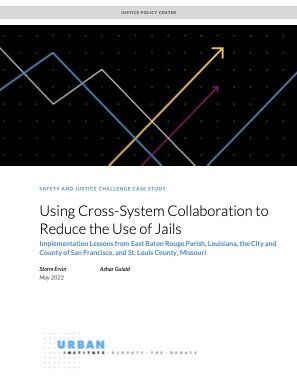Using Cross-System Collaboration to Reduce the Use of Jails Implementation Lessons from East Baton Rouge Parish, Louisiana, the City and County of San Francisco, and St. Louis County, Missouri
By Storm Ervin and Azhar Gulaid
With 11 million admissions a year, jails in the United States are overused, overcrowded, and carry significant individual and systemic impacts for people of color, who are disproportionately detained in jail pretrial. But people are detained in jail via actions and processes that occur across agencies and decision points, making cross-agency collaboration essential to system responses to reduce the jail population. The criminal legal system in the United States is a fragmented system that is siloed by varying decision points, such as arrests, the pretrial and prosecution stages, and sentencing. Within local jurisdictions, agencies and officials often use their discretion for decision-making with different goals in mind. This process limits the potential for innovation and system improvement and prevents shared goals or a “vision” for the overall system (Borakove et al. 2015). To counteract this fragmentation and effect systemwide change locally, jurisdictions can implement formal (or informal) collaborative bodies that cut across agencies and stakeholders and include non-system actors, such as representatives from community-based organizations and other local stakeholders. This case study is part of a series highlighting work supported by the MacArthur Foundation’s Safety and Justice Challenge (SJC) (box 1) and examines how East Baton Rouge Parish, Louisiana; the City and County of San Francisco, California; and St. Louis County, Missouri, implemented strategies intended to reduce local jail populations by creating collaborative bodies in their respective jurisdictions. To develop this case study, Urban conducted 22 semistructured interviews with stakeholders involved in the SJC work across the three jurisdictions. Interview participants had a range of connections to local justice reform and jail use; they worked in courts, pretrial services, probation, public health, community organizations and nonprofits, criminal justice coordinating councils, and SJC technical assistance providers. Urban supplemented these interviews with reviews of internal and public-facing reports and other relevant documentation, including data from the sites and the CUNY Institute for State and Local Governance.
Washington DC: Urban Institute, 220. 31p.


